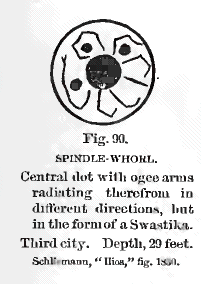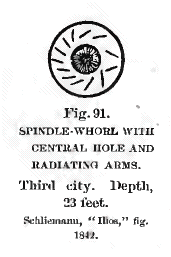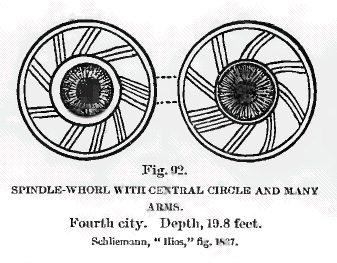

The Swastika
Dispersion of the Swastika
 Specimens of other crosses are presented
because the Swastika is considered to be a form of the cross. There may
have been no evolution or relationship between them; but no person is
competent to decide from a mere inspection or by reason of dissimilarity
that there was not. We have to plead ignoramus as to the growth
and evolution of both cross and Swastika, because the origin of both is
lost in antiquity. But all are fair subjects for discussion. There certainly
is nothing improbable in the relationship and evolution between the Swastika
and the cross. It may be almost assumed.
Specimens of other crosses are presented
because the Swastika is considered to be a form of the cross. There may
have been no evolution or relationship between them; but no person is
competent to decide from a mere inspection or by reason of dissimilarity
that there was not. We have to plead ignoramus as to the growth
and evolution of both cross and Swastika, because the origin of both is
lost in antiquity. But all are fair subjects for discussion. There certainly
is nothing improbable in the relationship and evolution between the Swastika
and the cross. It may be almost assumed.Evidence leading to conviction may be found in associated contemporaneous specimens. M. Montelius, an archæologist of repute in the National Museum at Stockholm, discovered eight stages of culture in the bronze age of that country, which discovery was based solely upon the foregoing principle applied to the fibulæ found in prehistoric graves. In assorting his stock of fibulæ, he was enabled to lay out a series of eight styles, each different, but with many presentations. He arranged them seriatim, according to certain differences in size, style, elegance or workmanship, etc., No. 1 being the smallest, and No. 8 the largest and most
 elaborate.
They were then classified according to locality and association, and he
discovered that Nos. 1 and 2 belonged together, on the same body or in
the same grave, and the same with Nos. 2 and 3, 3 and 4, and so on. Nos.
7 and 8 were associated, but not 6 and 8, nor 5 and 7, nor was there any
association beyond adjoining numbers in the series. Thus Moutelius was
able to determine that each one or each two of the series formed a stage
in the culture of these peoples. While the numbers of the series separated
from each other, as 1, 5, 8, were never found associated, yet it was conclusively
shown that they were related, were the same object, all served a similar
purpose, and together formed an evolutionary series showing their common
origin, derivative growth and continuous improvement in art, always by
communication between their makers and owners.
elaborate.
They were then classified according to locality and association, and he
discovered that Nos. 1 and 2 belonged together, on the same body or in
the same grave, and the same with Nos. 2 and 3, 3 and 4, and so on. Nos.
7 and 8 were associated, but not 6 and 8, nor 5 and 7, nor was there any
association beyond adjoining numbers in the series. Thus Moutelius was
able to determine that each one or each two of the series formed a stage
in the culture of these peoples. While the numbers of the series separated
from each other, as 1, 5, 8, were never found associated, yet it was conclusively
shown that they were related, were the same object, all served a similar
purpose, and together formed an evolutionary series showing their common
origin, derivative growth and continuous improvement in art, always by
communication between their makers and owners.Thus it may be with the other forms of crosses, and thus it appears to be with the circle and spiral Swastikas and those with ends bent in opposite and different
 directions.
Just what their relations are and at which end of the series the evolution
began, is not argued. This is left for the theorists and imaginists, protesting,
however, that they must not run wild nor push their theories beyond bounds.
Fig. 94 represents four crosses,
the main arms of which are at right angles, and each and all ends, instead
of being turned at an angle which would make them Swastikas, are bifurcated
and turn both ways, thus forming a foliated cross similar to the Maya
cross, the "Tree of life." Figs. 95,
96, and 97
show Greek crosses. The centers of the crosses are occupied by the central
hole of the whorl, while the arms extend to the periphery. In the centers
of the
directions.
Just what their relations are and at which end of the series the evolution
began, is not argued. This is left for the theorists and imaginists, protesting,
however, that they must not run wild nor push their theories beyond bounds.
Fig. 94 represents four crosses,
the main arms of which are at right angles, and each and all ends, instead
of being turned at an angle which would make them Swastikas, are bifurcated
and turn both ways, thus forming a foliated cross similar to the Maya
cross, the "Tree of life." Figs. 95,
96, and 97
show Greek crosses. The centers of the crosses are occupied by the central
hole of the whorl, while the arms extend to the periphery. In the centers
of the  respective
arms are the ubiquitous dots. The question might here be asked whether
these holes, which represented circles, stood for the sun symbol or solar
disk. The
respective
arms are the ubiquitous dots. The question might here be asked whether
these holes, which represented circles, stood for the sun symbol or solar
disk. The<< Previous Page Next Page >>
© 2004-2007 Northvegr.
Most of the material on this site is in the public domain. However, many people have worked very hard to bring these texts to you so if you do use the work, we would appreciate it if you could give credit to both the Northvegr site and to the individuals who worked to bring you these texts. A small number of texts are copyrighted and cannot be used without the author's permission. Any text that is copyrighted will have a clear notation of such on the main index page for that text. Inquiries can be sent to info@northvegr.org. Northvegr™ and the Northvegr symbol are trademarks and service marks of the Northvegr Foundation.

|